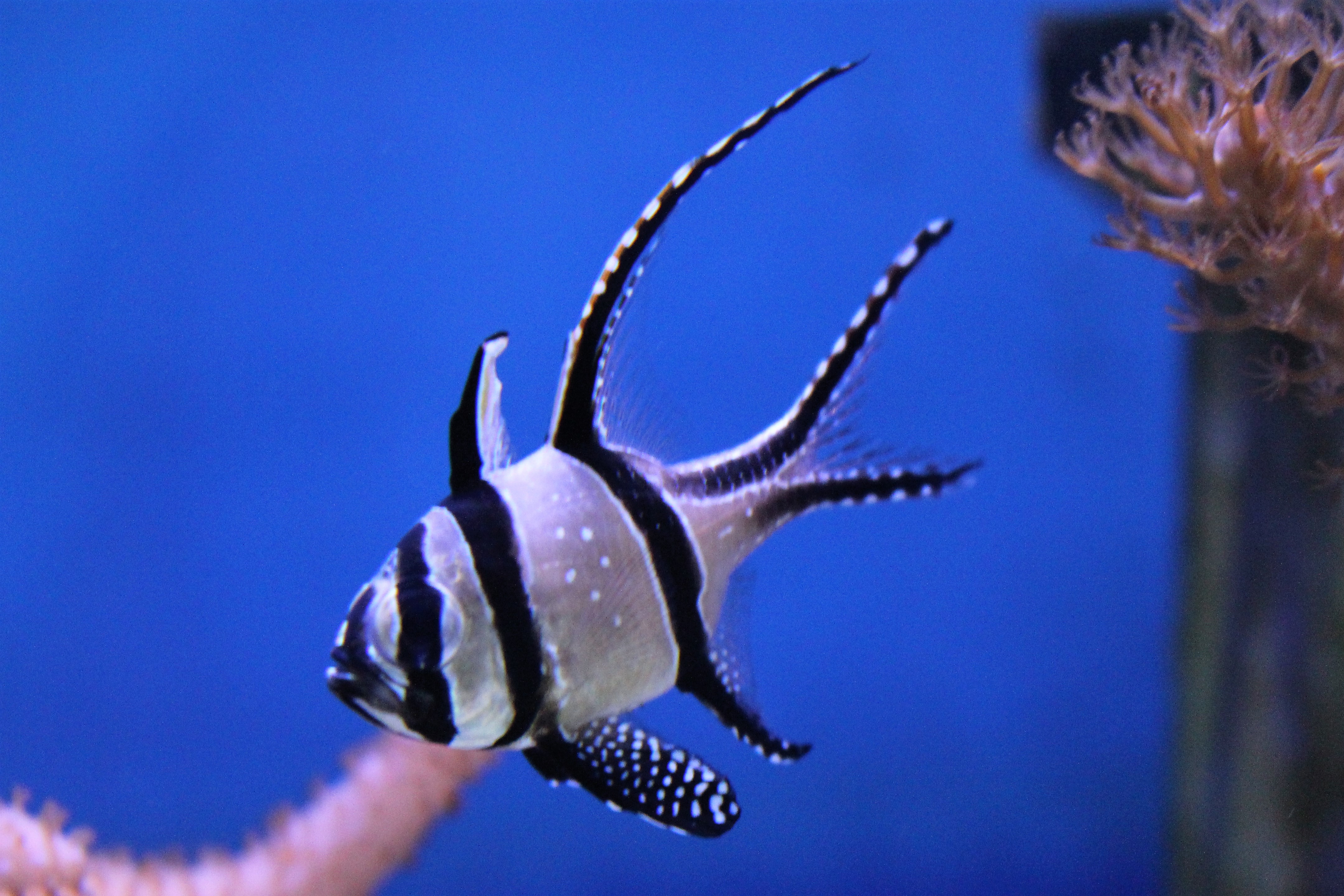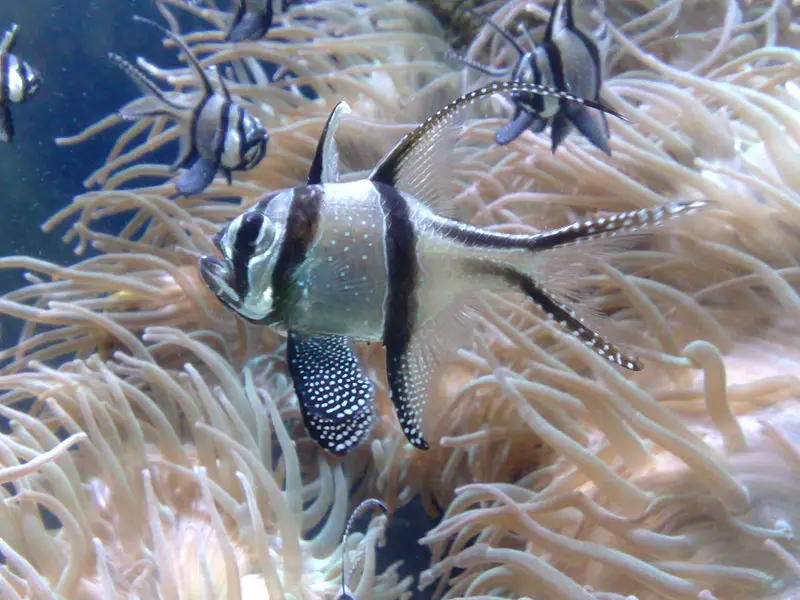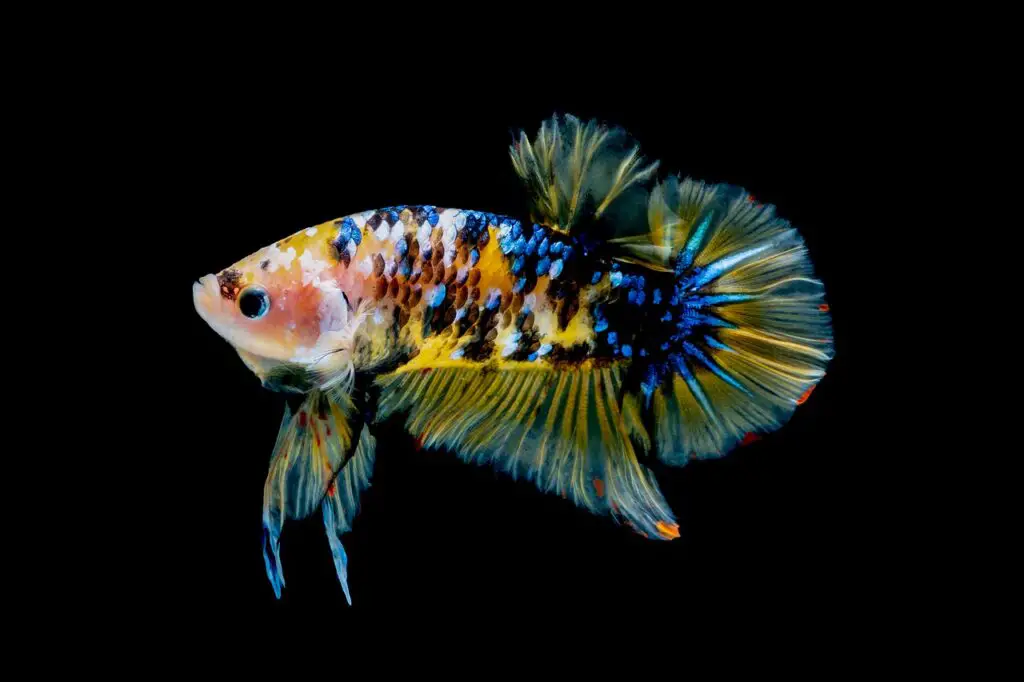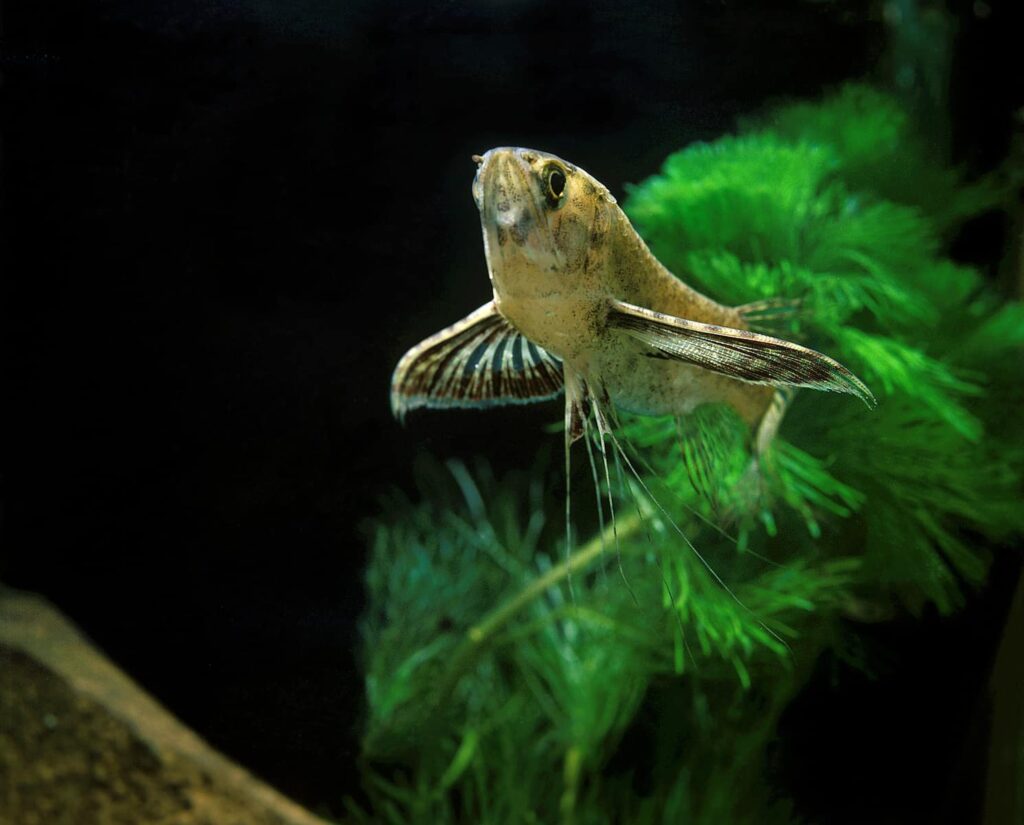The Banggai Cardinal Fish takes its name from the Banggai Islands in the region where they live in Indonesia. These fish are suitable for saltwater aquariums and have some interesting features. It’s actually known as the Kaudern’s cardinal fish in some cases, so be careful not to get too confused when looking for the right adoptees!

In this guide, we’ll take you through everything you need to know about this popular saltwater fish!
- Fish Lifespan: Around 5 Years
- Tank Size: At Least 20 Gallons
- Water Temperature: Between 74-82 F
- pH: Between 8.1 and 8.5
- Hardness: Between 8 and 12 dKH
- Compatibility: Compatible with Clownfish, other Cardinals, Angelfish
- Fish Size: Up to3 Inches
How do you take care of Banggai Cardinalfish?
They are generally not aggressive, easy to feed and their skin condition is a good indicator of their wellbeing. You will easily spot any discolouration on their skin and also recognize how well they are responding at feed times!
All of these characteristics make them a good choice for children and those inexperienced in owning an aquarium.
They are therefore relatively easy to care for, especially if you regularly and routinely monitor their activity and how well they respond to food as a stimulus, how they are moving through the water and whether or not they are shying away from or interacting with other fish in the aquarium.

Being easy to breed, it may be prudent to buy a small number as you will not want to be in the position of reforming too many offspring, if you discover that you have ideal mating conditions and numerous offspring arise!
Buying one male and two or three females may be the best starting point – however, sexing these fish can be difficult – and so if no offspring arrive, it could be that you have only females in the aquarium.
The males release fully formed ‘fry’ from their mouths after incubating them there once the eggs have evolved and can begin to thrive independently.
This is an amazing event to observe but seldom seen by many fish enthusiasts. This usually occurs approximately three weeks after spawning and the fry are quite well developed.
When choosing a pair of these fish, you may see some aggression between fish in a group and usually two or more males, oppress one another.
If therefore, you are shopping for a male and female, it is recommended you select one from a group who appear to be ‘sparring’ and another which appears to be more serene, likely to be some distance from the group.
Choosing your fish is interesting and exciting, so best to take your time and study the characters of those you are taking home, if you want harmony in the aquarium and maybe babies! Adult fish can grow up to a length of approximately 3 inches.
Are Banggai Cardinalfish Hardy?
Banggai cardinal fish are ‘relatively’ hardy, provided their environment is as close to their natural habitat as possible in terms of light and nourishment.
If the fish become too stressed, as with any living creatures, reproduction and even survival may be at risk.

Do not be disappointed if your cardinals do not mate. Perhaps you only have females or perhaps the time is just not right! It is not unusual for mating and spawning to occur without owners being aware until fry are released, so it is advisable to keep a watchful eye for this happening!
What do Banggai cardinal fish eat?
The Banggai cardinal is a carnivore. Therefore, there is always the chance that it will try to prey on smaller fish or other creatures in your tank. However, they can sometimes be a little picky when it comes to their diet.
Therefore, it’s generally a good idea to try a few different things out when feeding them for the first time. In some cases, you may be able to feed them successfully with frozen meat such as shrimp.
However, they will also likely take well to live shrimp, meaning that if you want to mix things up, you can.
It’s also worth making sure that you give your Banggai cardinal fish enough of the vitamins and nutrients it needs through enriched fish flakes. Don’t worry, this isn’t ‘cheating’ on their diet, as it makes sure that they are getting what they need to be able to persist in their new home.
How many fish can be in a cardinal tank?
It’s generally advisable that you set up a tank of around 30 gallons for these fish. However, to start with, a 20 gallon tank may be enough.
The general rule of thumb for keeping any fish in a home saltwater tank is that there should be around two gallons per one inch of fish.
Considering that the Banggai can grow to be around 3 inches in length, it’s not unreasonable to assume you’ll need at least 20 gallons to house three of them.
The number of fish you should host in your cardinal tank can vary. These fish can live well together and are fairly slow on the pace. Therefore, it’s generally a good idea to have a couple grouped together so they don’t get overwhelmed.
Different cardinal species may vary when it comes to temperament as well as compatibility with other fish.
Therefore, do be careful when it comes to overstocking your tank. Too many fish in the same area might stress these sometimes timid creatures out, meaning that a bigger tank is always a good idea.
Are Cardinals reef safe?
On the whole, cardinals are pretty reef safe.
However, it all depends on experience – there are some fish keepers who may tell you otherwise. As these fish come from coral reefs, it’s perhaps not surprising if they take a nibble or two on any coral you may have in the tank.
However, on the whole, they probably won’t cause too much hassle to your home reef, nor to the critters and creatures they share their home with.
Banggai cardinals are carnivorous on the whole, which means it’s very, very unlikely that they will ever take a fancy to anything that isn’t meat. However, this presents a whole new problem.
Yes, they might be reef safe, but are they necessarily safe to keep in the same tank as a host of other fish? Maybe not, if they are smaller.
How many pajama cardinals should I get?
That all depends on the size of your tank! As mentioned, the two gallons to every inch of fish rule tends to work well, though you may find that this doesn’t give your fish the space they need or want to swim around and hide.
Pajama Cardinals fish tend to flutter around very slowly at times and will also enjoy hiding spots – not uncommon, on the whole, for many saltwater fish to show these habits. Therefore, a big tank is going to be a good spot.

These particular cardinals – the Banggai variety – will do well in smaller schools and groups, however, it’s not unheard of for them to get on well in small patches with other types of fish. Check out our note on compatibility for more information.
Therefore – do some mathematics. If your cardinals can grow to be 3 inches long, then you are going to need around 20 gallons in your tank for three fish.
However, add 10 gallons onto this to give them a bit of extra space, especially if you have coral reef in the tank, too. In our collective experience, it’s always better to try and go larger than to make things smaller or more restrictive.
More space means less stress for your cardinals – we all need a bit of breathing space, after all!
Should I adopt a Banggai Cardinalfish?
If you have an interest in breeding fish, these can offer a marvellous opportunity to not only increase your numbers but also witness the phenomena of the male incubating the eggs and releasing the fry.
These are attractive, graceful fish with a mild temperament and colourful, elegant appearance.
As they have a usually calm disposition, housing a number in the same tank, providing there is space, should not pose any problem. Small schools tend to work best for the Banggai, but they tend to be a real delight regardless of the grouping.
These fish are especially noteworthy that because of their popularity and over fishing, plus the loss of some coral reefs, these fish may become an endangered species, so breeding them in aquariums may help sustain these beautiful creatures.
As mentioned, breeding the Banggai tends to be a pretty easy endeavour. They are a little picky at times when it comes to food and may not eat as much as your other saltwater tank mates, meaning it’s probably worth keeping an eye on them to make sure no other critters are bullying them off during feeding time.
Otherwise, if you are a complete novice at keeping fish, you really won’t have much of a problem with these cardinals.



